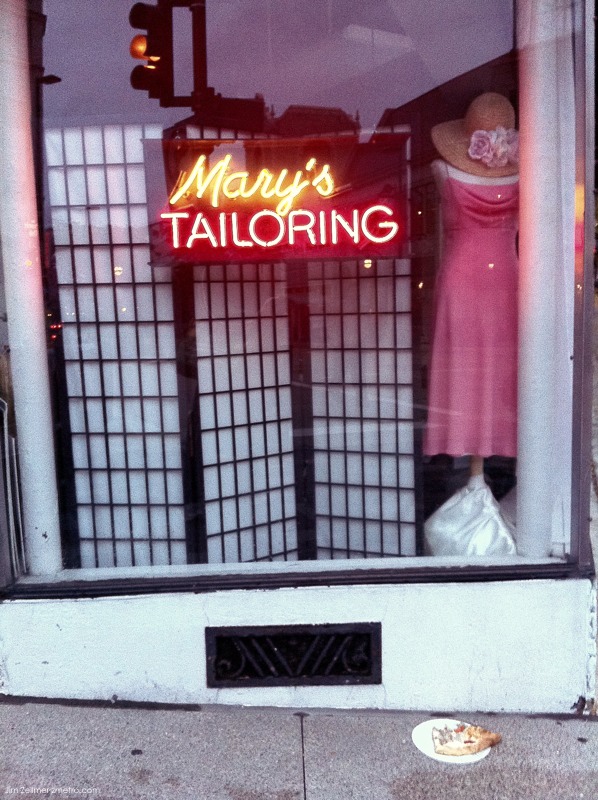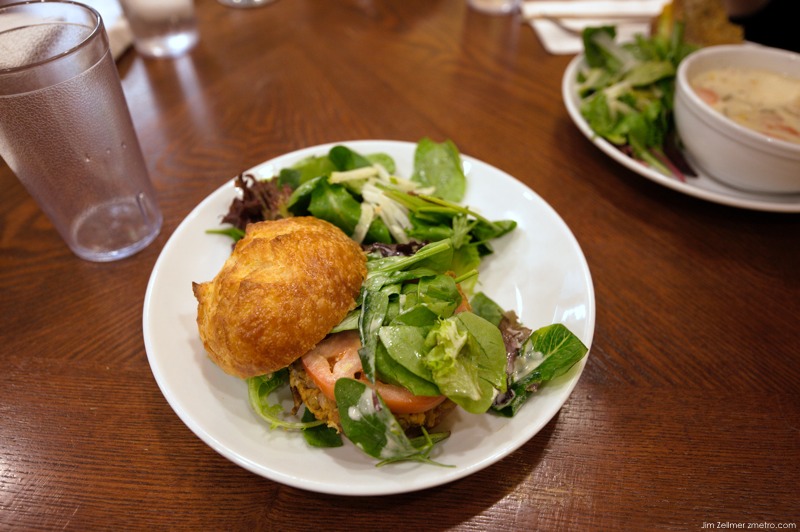
Monthly Archives: September 2010
Saturday Morning; State Street – Madison

Foxconn: The Man Who Makes Your iPhone
Frederik Balfour & Tim Culpan:
The interview took place at Longhua, the entrance to which looks like a border crossing, with seven toll-booth-like lanes and uniformed guards. Although drab and utilitarian, the campus is a fully functioning city, with fast-food joints, ATMs, Olympic-size swimming pools, huge LED screens that flash public-service announcements and cartoons, and a bookstore that sells, among other things, the Chinese-language translation of the Harvard Business Review. Prominent on display are biographies of Gou, one of which collects his many aphorisms, including “work itself is a type of joy,” “a harsh environment is a good thing,” “hungry people have especially clear minds,” and “an army of one thousand is easy to get, one general is tough to find.”
Foxconn is now the biggest exporter out of China, and its general is the richest man in Taiwan, estimated by Forbes to have a personal fortune of $5.9 billion. He says he cannot confirm that figure, however, as he does not keep track. “I have one guy in charge,” Gou says in heavily accented English that he picked up while touring the U.S. in the 1980s. “Every year he gives me a piece of paper and says, ‘Hey, this is how much.’ I think for me, I am not interested in knowing how much I have. I don’t care. I am working not for money at this moment, I am working for society, I am working for my employees.”
The colossus that Gou (pronounced “Gwo”) runs today started with a $7,500 loan from his mother. His first world headquarters was a shed he rented in 1974 in a gritty Taipei suburb called Tucheng, which means Dirt City in Mandarin. Gou, then 23, had done three years of vocational training and served in the military. He then worked for two years as a shipping clerk, where he got a firsthand view of Taiwan’s booming export economy and figured he ought to stop pushing paper and get into the game. With the cash from his mother, he bought a couple of plastic molding machines and started making channel-changing knobs for black-and-white televisions. His first customer was Chicago-based Admiral TV, and he soon got deals to supply RCA, Zenith, and Philips (PHG).
Imagining his future success, he practiced signing his name in English over and over until he had perfected it. He remains proud of it today, walking over to a whiteboard during the interview and signing with a schoolboy flourish. It looked like the perfect cursive script from the credits of I Love Lucy.
Lunch With Tony Blair
I had hoped I might meet Tony Blair at one of London’s more bustling venues – mainly, I confess, because I wanted to measure the reaction of the throng. But the rules of Lunch with the FT leave the choice with the guest. So, after a certain amount of cloak and daggery, insisted upon by the police protection officers who still accompany him everywhere, I arrive at Blair’s local Italian, Locanda Locatelli.
It is one of those restaurants comfortable with celebrity. On a weekday lunchtime most tables seem to be occupied by business types but Madonna is said to be among the evening regulars. Our corner booth offers a panoramic view of polished wood, fabric wall coverings and soft leather banquettes. A head or two turns discreetly as Blair enters. No one is impolite enough to stare.
Britain’s former prime minister presents a conundrum. His memoir has invited torrents of invective from enemies (critics is much too soft a word) among metropolitan elites. Yet copies of A Journey are flying off the shelves as “real people” open their wallets to read Blair’s version of events. He did, after all, win three elections and put Britain back on the international stage. Then again, he also stood shoulder to shoulder with George W Bush in Iraq.
Football Saturday Style






Madison Sourdough’s Impressive Lunch



Worth a stop, Madison Sourdough.
What Did We Do, Pre iPhone; Part II


I talked with an iPhone owner during a recent conference. While she was tapping away on email and a variety of apps, she mentioned “I don’t know what I did before….”.
Changing everything, including education.
US Tax Reform: How about this for a tax plan: cut most people’s taxes by half, eliminate the need to file returns, and provide the Treasury with a better way to reduce the deficit. Sound impossible? It’s not. Here’s how to get it done.
Keith Libbey & Evan Thomas:
Most Americans spend dozens, if not hundreds, of hours attempting, not always successfully, to do their tax returns. We spend almost $30 billion paying accountants to fill out the complicated forms, and by some estimates we devote $110 billion of our own labor just keeping track of all the necessary records and paperwork. Americans pay about 85 percent of the taxes they owe, better than in most countries, but the shortfall is still a drain on the Treasury (and the rich seem to find a way to avoid taxes legally). Is this costly, demoralizing struggle between the IRS and the rest of us really necessary?
The short answer is no. There is a way to relieve almost all Americans of the annual April 15 nightmare. What’s more, it’s a necessary first step toward a plan to cut the looming federal deficit. The time is right for thoroughgoing tax reform—a true clean slate—that will bring in more revenue while giving the public a greater sense of fairness. The reforms we propose will even allow most people to take home more pay than they do now.
The place to start is to cut almost everyone’s payroll and income taxes by half. Yes, you read that right. Cut most tax rates, which now run from 10 to 39 percent, by half. All individual taxes would be collected through company withholding taxes on compensation (salary, bonus, deferred payments, etc.) and investment income (dividends, interest, capital gains, rents) to individuals. The very rich—those making more than $2 million a year—would still pay a top tax rate of 30 percent on earned income. The rate on investment income would be 15 percent. The result: individuals would not have to file tax returns, most Americans would take home more pay than they do now, the tax base would be broadened, and the AMT—the alternative minimum tax, which sweeps up more taxpayers every year—would be eliminated.
Too good to be true? There’s no free lunch. The revenue lost to the government—roughly half of all personal federal taxes—has to come from someplace else. The best fix is to eliminate all deductions and exemptions for individual taxpayers—all those tax breaks that were intended to promote economic activity or serve worthy social goals but have ended up creating myriad unfair outcomes. It’s true that the wealthiest 1 percent currently pays about 18 percent of all taxes. Still, thanks to clever tax dodges, the top 400 income earners pay an average tax rate of 16.6 percent; megabillionaire Warren Buffett notes that his secretary pays a higher tax rate than he does.
Digital Maoism
FROM “Wikinomics” to “Cognitive Surplus” to “Crowdsourcing”, there is no shortage of books lauding the “Web 2.0” era and celebrating the online collaboration, interaction and sharing that it makes possible. Today anyone can publish a blog or put a video on YouTube, and thousands of online volunteers can collectively produce an operating system like Linux or an encyclopedia like Wikipedia. Isn’t that great?
No, says Jaron Lanier, a technologist, musician and polymath who is best known for his pioneering work in the field of virtual reality. His book, “You Are Not A Gadget: A Manifesto”, published earlier this year, is a provocative attack on many of the internet’s sacred cows. Mr Lanier lays into the Web 2.0 culture, arguing that what passes for creativity today is really just endlessly rehashed content and that the “fake friendship” of social networks “is just bait laid by the lords of the clouds to lure hypothetical advertisers”. For Mr Lanier there is no wisdom of crowds, only a cruel mob. “Anonymous blog comments, vapid video pranks and lightweight mash-ups may seem trivial and harmless,” he writes, “but as a whole, this widespread practice of fragmentary, impersonal communication has demeaned personal interaction.”
If this criticism of Google, Facebook, Twitter and Wikipedia had come from an outsider—a dyed-in-the-wool technophobe—then nobody would have paid much attention. But Mr Lanier’s denunciation of internet groupthink as “digital Maoism” carries more weight because of his career at technology’s cutting edge.
God’s Glory: A Fabulous Madison Sunset
